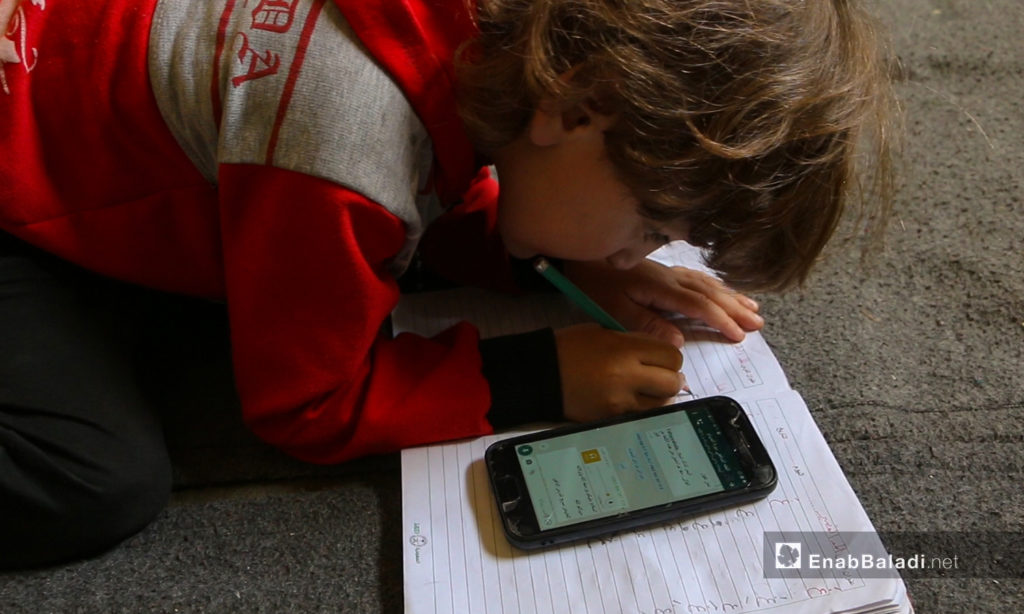Idlib -Youssef Gharibi
After novel Coronavirus infection (COVID-19) deprived his children of face to face classrooms, Ahmad al-Issa had to start online teaching classes, highlighting to Enab Baladi that “ Distance learning is better than no learning at all.”
It has been six months since the Education Directorate in the opposition-held province of Idlib launched a distance education project after schools’ repeated closure due to COVID-19 restrictions. This project is still operational even though schools were re-opened at the end of last September due to the continuing need and demand for remote-learning.
Distance education
Mustafa Haj Ali, the head of the education directorate’s media office in Idlib governorate, pointed out that “the lack of options” was the primary motivation for starting “the distance education” project called by the administrative board of the education directorate.
With a volunteer team, who received training on how to teach students online, using electronic devices and appropriate applications, the education directorate faced the coronavirus lockdown, which was imposed temporarily last March. The lockdown was reimposed after the first case of the coronavirus was registered on 9 July.
The lessons, which are based on the revised Syrian curriculum, are published online after passages of glorification of “ the Baath” party and the Syrian regime’s leaders were deleted. In fact, the educational guidance department had assigned an audit and monitoring committee which revised and checked the curriculum “ to be of material and moral value, with a good technology and revision,” Haj Ali told Enab Baladi.
He also pointed out that the committee coordinated with the preparation teams to avoid mistakes and repetitions.
The lessons were published on Youtube successively and included all educational stages until their number increased to 500 lessons at the beginning of October.
Even though the number of views of the learning videos on Youtube was very low initially, they got tens of thousands of views so far. The actual watch hours exceeded 3,500 per hour, according to the electronic statistics platform.
Ahmad al-Issa, “the teachers’ experience,” has improved the quality of the videos posted during the past months; the videos were earlier of poor quality: bad audio and blurry footage. However, the percentage of students benefiting from the distance education project“is not at the required level ”in his estimation. He indicated that the parents’ interest and cooperation with teachers and students is a prerequisite.
Distance education is fun but exhausting
Students’ parents told Enab Baladi that their children enjoy online lessons because children in general love to hold the phone, watch Youtube videos, and play video games. However, since the e-learning came into force, “We have been able to change our children’s orientation; instead of spending time watching Youtube videos, now our children are attending online classes (learning-related videos) and communicating with their teachers. Now, their love to learn more via distance education grew stronger,” Abdulaziz Al-Ahmad al-Khalaf told Enab Baladi, speaking about his daughter’s experience in distance education.
Al-Khalaf loved e-learning because the student can watch learning-related videos over and over again, get back to the teacher easily for any question or inquiry, and the students’ parents can follow up on their children’s lessons. Al-Khalaf stressed that the first and last effort is for the teacher to facilitate the students’ e-learning experience properly.”
Despite all the difficulties students encounter in receiving online classes, such as the poor Internet connection, the project has spared families from buying school stationery, whose high prices constitute a burden on families, according to al-Khalaf. He pointed out that the continued use of the project and its integration with education in schools is a “good idea” because it allows the teachers to send information to the students, who can, in turn, send their assignment over the phone.
Khaled al-Khaled, the director of “ the distance education project,” believes that online lessons will remain associated with physical education classes, adding that online classes can be “our last option” when schools cannot be re-opened due to the lack of preventive measures against the coronavirus infection. Nearly two thousand coronavirus infected patients are recorded in northwestern Syria since mid-October, according to the Assistance Coordination Unit (ACU).
Lack of financial resources devoted to education
Education continued to be provided in Idlib despite the security risks and the lack of support; schools returned to operate after being stopped repeatedly due to lack of security and sometimes due to displacement. Besides, hundreds of schools went out of service due to bombing or because they turned into shelters for the displaced.
According to the most recent report by the United Nations Office for the Coordination of Humanitarian Affairs (OCHA), lack of financing resources or appropriate funding is hampering the delivery of quality education in the region, amid shortages of educational materials intended for teachers and students.
With 30 percent of the region’s population unable to access the Internet and smartphones, the “Distance Education” project cannot be seen as the best choice for all students.
Abdullah al-Absi, the director of Idlib’s educational complex, told Enab Baladi that there are currently 650,000 students in Idlib, of whom 400,000 are enrolled in their lessons, and 250,000 students drop out of the educational system.
Al-Absi concluded that “When enough support is provided to schools, there will be more children to join classes.”

